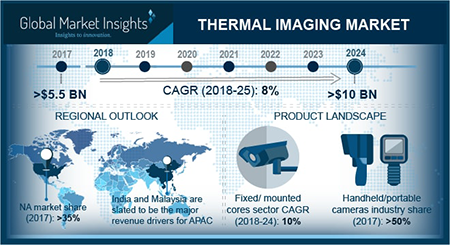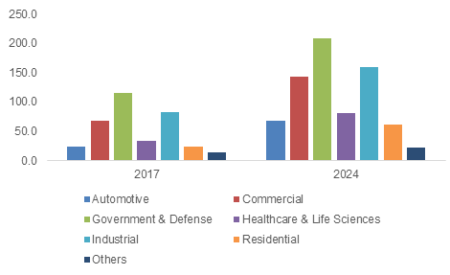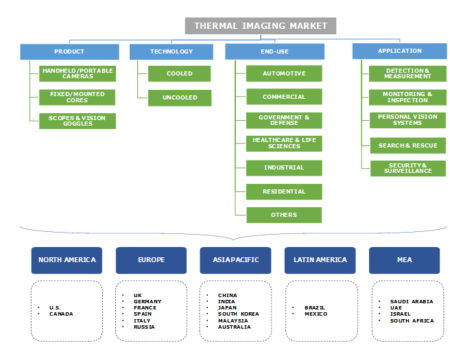
According to a new research report by the market research and strategy consulting firm, Global Market Insights, Inc, the Thermal Imaging Market to reach US$10 Billion by 2024.
The cooled thermal imaging market accounted for over 50% of the revenue share in 2017, with the chief growth drivers being the surging demand for security, surveillance, and firefighting applications for better accuracy and image details.
Indoor applications including emergency management and building security are poised to offer growth opportunities for cooled thermal imaging product suppliers. The segment is forecast to lose share in the coming years to uncooled technology due to the growing number of application industries for the latter.
China thermal imaging market size, by end-use, 2017 & 2024 (USD Million)
The demand across healthcare & life sciences applications in the thermal imaging market is expected to grow at a rapid pace due to the provision of advanced diagnostic and visualizations offered by such solutions.
Thermography facilitates quantifiable, accurate, and non-invasive diagnostic detection by means of changes in surface temperatures. In the healthcare sector, thermography applications include muscle strain assessment, vascular evaluation, and bleeding point detection. In addition, the technology helps to identify the tissue damage site in case of injuries, aiding the sports medicine field.
Thermography helps in the detection of fever and related signs of infection. Thus, the technology has been used extensively by airports during an epidemic outbreak such as Severe Acute Respiratory Syndrome (SARS), swine flu, and Ebola to screen passengers with elevated body temperatures. Hyperspectral imaging and remote sensing are expected to serve as the key opportunity domains for thermal imaging market expansion.
Thermal Imaging Industry Background
The rising awareness of the thermal imaging market for applications other than security & surveillance, such as detection, monitoring, and inspection, to offer additional revenue growth opportunities for industry players, particularly in high industrial demand markets including China, India, Middle East, and South America.
The miniaturization of infrared detector cores opens diverse avenues for the deployment and integration of the technology with other consumer electronic devices. In addition, the emerging application segments in the market including personal vision systems have led to the development of low-cost solutions that meet the needs of the end users.
Personal vision system devices are expected to register the fastest growth due to the availability of low-cost solutions and demand for technology in consumer outdoor use such as hunting and mountain sports, law enforcement, and border patrol. The emergence of unmanned and airborne vehicles in defense applications is expected to stimulate thermal imaging market growth.
Handheld/portable cameras constitute the largest segment accounting for over 50% of the market revenue share in 2017. Growing security concerns coupled with technological advancements, reduction in size, and an average selling price are the major factors driving the demand for handheld imagers. The ability of such devices to track, locate, capture, and record criminal activity in adverse conditions is expected to favorably drive the handheld thermal imaging market demand.
Major thermal imaging market drivers in Asia Pacific countries including India, Malaysia, and South include the rapid pace of technology adoption and penetration in the region. The declining price of thermal cameras and the presence of regional vendors offering low-cost solutions are expected to favorably impact the market growth in India and China.
Major vendors in the thermal imaging market space are FLIR Systems, Leonardo DRS, Raytheon Company, and Fluke Corporation. The market is characterized by stiff price competitiveness and innovative solutions.
To sustain competition, players have been focusing on vertical integration to cut down input costs and developing technologically-advanced products. In addition, the expansion of product offering to penetrate new application verticals, such as smartphone integration offered by FLIR One and Seek Thermal Compact, enables vendors to garner additional revenue thermal imaging market growth opportunities.
The integration of thermal camera cores into CCTV applications creates a bi-spectral camera solution that enables users to capture both visible image and thermal heat signatures for accurate surveillance and reduction in false alarms.
The combination of thermography with other complementary sensing technologies, such as radar, laser, sonar, environmental, and chemical sensing, increases the functionality of the systems. Classification-based analytics and networking-enabled thermal cameras improve the response time for emergency situations while lowering the costs associated with the downtime and potential hazards contributes to the thermal imaging market.
Source: gminsights.com


